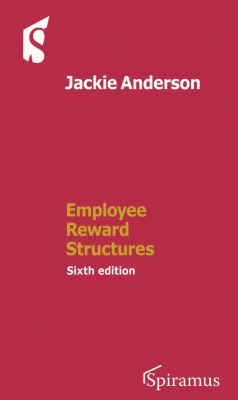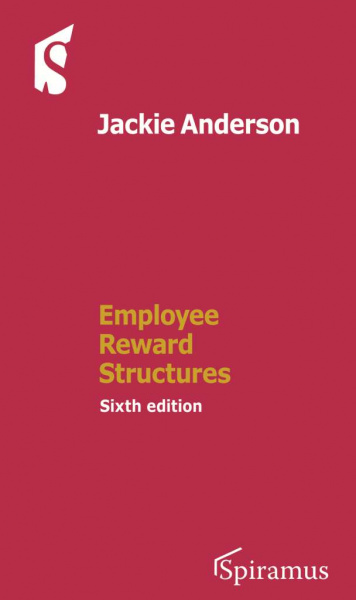Employee Reward Structures
Sixth edition
This is a comprehensive guide to the tax treatment of executive reward packages, from recruitment to termination. Includes a comprehensive glossary of terms, checklists and flowcharts.
The sixth edition contains analysis of: the following changes:
- Taxation of pensions contributions, cap on tax relief for contributions, additional rate relief restriction, alignment of pension input periods, reduction in lifetime allowance, freedom to draw down lump sums
- Termination payments Significant proposed changes in treatment
- Employee Benefit Trusts: Important case law developments (Murray Group Holdings)
- Employee Shareholder Shares: Changes to the relief and proposal to end agreements
- Employee Share Plans: Streamlining and Self-certification
- Benefits in kind: Removal of ‘lower-paid employee’ status
Includes complete work on CD-ROM (with cross-references and website resources hyperlinked) with the printed book.
- AvailablePaperback9781910151389484 pagesList Price: GBP 125.00 Add to basket
- AvailablePDF9781910151396484 pagesList Price: GBP 62.50 Add to basket
This is a comprehensive guide to the tax treatment of executive reward packages, from recruitment to termination. Includes a comprehensive glossary of terms, checklists and flowcharts.
The sixth edition contains analysis of: the following changes:
- Taxation of pensions contributions, cap on tax relief for contributions, additional rate relief restriction, alignment of pension input periods, reduction in lifetime allowance, freedom to draw down lump sums
- Termination payments Significant proposed changes in treatment
- Employee Benefit Trusts: Important case law developments (Murray Group Holdings)
- Employee Shareholder Shares: Changes to the relief and proposal to end agreements
- Employee Share Plans: Streamlining and Self-certification
- Benefits in kind: Removal of ‘lower-paid employee’ status
It covers the broad spectrum of employee reward structures, from the tax-efficient structuring of a termination payment to the complex anti-avoidance rules aimed at share-based remuneration. It provides guidance on the more common salary and benefit arrangements, as well as dealing with areas where unexpected tax charges can arise, particularly in the field of share options and other equity incentives.
Includes complete work on CD-ROM (with cross-references and website resources hyperlinked) with the printed book.
About the author: Jackie Anderson LLB, ACA, CTA has her own practice, LHA Consulting Ltd.
Acknowledgements
Contents
List of abbreviations
1 Cash Bonus Plans, “Golden Hellos” and Phantom Shares
1.1 Cash Bonus Plans
1.2 Golden Hellos
1.3 Phantom Share Plans
2 Non-Cash Benefits
2.1 Taxation of Benefits: General Rules
2.2 Flexible Benefits
2.3 Exempt Employee Shareholder Shares
2.4 Incentive Award Schemes
2.5 Cars
2.6 Healthcare and Medical Benefits
2.7 Life Assurance
2.8 Childcare Vouchers
2.9 Workplace Nurseries
2.10 Nurseries outside the Workplace
2.11 Workplace Meals
2.12 Mobile Telephones
2.13 Vouchers
2.14 Pensions
2.15 Job-related Accommodation
2.16 Accommodation that is Not Job-Related
2.17 Recreational Facilities
3 Registered Pension Schemes
3.1 Introduction
3.2 Description
3.3 Disclosure
3.4 Regulatory Treatment
3.5 Tax Treatment of Member
3.6 Summary of Benefits Payable from Registered Money Purchase Pension Schemes
3.7 Tax Treatment of Trustee/Scheme Administrator
3.8 Tax Treatment of Employer
4 Employer-Financed Retirement Benefits Schemes
4.1 Description
4.2 Regulatory Treatment:
4.3 Tax Treatment of Member:
4.4 Tax Treatment of Trustee/Scheme Administrator
4.5 Tax Treatment of Employer:
5 Employee Benefit Trusts and Disguised Remuneration
5.1 Uses of Employee Benefit Trusts
5.2 Taxation of a Beneficiary
5.3 Taxation of Company
5.4 Capital Gains Tax
5.5 Collection of NIC
5.6 Taxation of Individual Settlor
5.7 Taxation of the EBT Trustee
5.8 Company Law
6 Unapproved Option Plans
6.1 Description
6.2 Key Features of Share Options
6.3 Company Law Issues
6.4 Designing a Share Option Plan and Drafting the Rules
6.5 Sources of Shares
6.6 Accounting Treatment
6.7 Summary of Advantages and Disadvantages of Share Options
6.8 Taxation of Options
6.9 Assignment or Release of Securities option
6.10 Frequently Asked Questions on Unapproved Share Options
7 Tax-Favoured Share Plans: General
7.1 Overview
7.2 Requirements common to SIP, SAYE and CSOP
7.3 Requirement common to SIP and SAYE: No Discouraging Features
7.4 Requirements common to SAYE and CSOP
7.5 Requirement common to EMI, SAYE and CSOP
7.6 Requirements common to EMI and CSOP
7.7 Requirements common to EMI, SAYE, CSOP and SIP
8 EMI
8.1 Description
8.2 Checklist for Granting an EMI Option
8.3 Qualification Requirements for the Relevant Company and its Shares
8.4 Tests applying to the Shares
8.5 Qualification Requirements for the Optionholder
8.6 Qualification Requirements for the Option
8.7 The Terms of the Option
8.8 Documentation and Registration
8.9 Taxation of the Employee
8.10 Summary of Advantages and Disadvantages of EMI Options
8.11 Frequently Asked Questions on EMI Plans
9 CSOP
9.1 Description
9.2 Checklist for Implementation of a CSOP
9.3 Approval Requirements for the Shares
9.4 Approval Requirements for Participating Companies
9.5 Approval Requirements for the Optionholder
9.6 Approval Requirements for the Plan
9.7 Approval Process
9.8 Valuation Issues
9.9 Tax Treatment of Employee
9.10 Tax Treatment of Employer
9.11 Accounting Treatment
9.12 Frequently Asked Questions
10 SAYE
10.1 Description
10.2 Checklist for Implementation of an SAYE
10.3 Approval requirements for the Shares
10.4 Approval Requirements for Participating Companies
10.5 Approval Requirements relating to Optionholders
10.6 Approval Requirements for the Plan
10.7 Approval Process
10.8 Selecting a Savings Carrier
10.9 Valuation Issues
10.10 Tax Treatment of Employee
10.11 Tax Treatment of Employer
10.12 Accounting Treatment
10.13 Summary of Advantages and Disadvantages of SAYE Options
10.14 Frequently Asked Questions for SAYE
11 SIP
11.1 Overview
11.2 Free Shares
11.3 Partnership Shares
11.4 Matching Shares
11.5 Dividend Shares
11.6 Checklist for Implementation of a SIP
11.7 Approval Requirements for the Shares
11.8 Approval Requirements for Participating Companies
11.9 Approval Requirements relating to Participants
11.10 Approval Requirements for the Plan
11.11 Other Features of the SIP
11.12 Approval Process
11.13 Selecting a Trustee/Administrator
11.14 Tax Treatment
11.15 Summary of Advantages and Disadvantages of SIP
11.16 Frequently Asked Questions on SIPs
12 Exempt Employee Shareholder Shares
12.1 Introduction
12.2 Legal Requirements
12.3 Exemption from Income Tax on Acquisition
12.4 Exemption from Distribution Treatment on Disposal
12.5 Exemption from Capital Gains Tax on Disposal
12.6 National Insurance
12.7 Employee with Material Interest
12.8 Corporation Tax Issues
12.9 Accounting and Company Law
13 Share Purchase and Award Plans: Overview
13.1 Structure of this Section
13.2 Company Law Issues
13.3 Common Ways of Providing Shares
13.4 Unrestricted Shares
13.5 Restricted Shares
13.6 Convertible securities
13.7 Nil-paid and Partly-paid Shares
13.8 Ratchet Arrangements
13.9 Value Freezing/Growth Shares/Hurdle Share
13.10 Flowering Shares
13.11 Joint Ownership Plans
13.12 Share Appreciation Rights
13.13 Discounted Share Offers
14 Tax Treatment of Employee on Acquisition of the Securities
14.1 Unrestricted Shares
14.2 Restricted Securities
14.3 Convertible securities
14.4 Nil-Paid and Partly-Paid Shares
14.5 Ratchet Arrangements
14.6 Value Freezing/Growth Shares/Hurdle Shares
14.7 Flowering Shares
14.8 Joint Ownership Plan
14.9 Share Appreciation Rights
15 Tax Treatment of Employee after Acquisition of the Securities
15.1 Unrestricted Securities
15.2 Restricted Securities
15.3 Convertible securities
15.4 Securities Acquired for less than Market Value
15.5 Ratchet Arrangements
15.6 Value Freezing/Growth Shares/Hurdle Shares
15.7 Flowering Shares
15.8 Joint Ownership Plan
15.9 Entrepreneurs’ Relief
15.10 Income Tax Relief for Capital Losses
16 Restricted Securities Elections
16.1 The Elections
16.2 Deciding to Make an Election
16.3 Reporting
17 Legacy Rules
17.1 Forfeitable Shares Acquired before 17 March 1998
17.2 Conditional Securities Acquired before 16 April 2003
17.3 Removal or Variation of a Restriction on Securities Acquired Before 1 September 2003
18 Anti-Avoidance and Special Situations
18.1 Pre-acquisition Avoidance Cases
18.2 Securities that have been Artificially Depressed in Value
18.3 Artificially Enhanced Securities
18.4 Securities Disposed of for More than Market Value
18.5 Post-Acquisition Benefits
19 Corporation Tax Relief
19.1 General Principles
19.2 CTA 2009, Part 12
19.3 Relationship between Part 12 and other deductions
19.4 CTA 2009, s1288
19.5 CTA 2009, sections 1290 to 1297
19.6 Establishment and Operation of Approved Schemes
19.7 Pension Contributions
19.8 Cash Cancellation Payments
19.9 Transfer Pricing and Anti-Arbitrage Issues
19.10 Termination Payments
20 NIC Recovery and Transfers
20.1 Primary NIC
20.2 Secondary NIC Transfers
21 Employment-Related Loans
21.1 Prohibition on Loans to Directors
21.2 Loans to Director acting as Trustee
21.3 Tax on Cheap Loans to Directors and Employees
21.4 Consumer Credit Act 1974
21.5 Loans to Acquire Shares in Close Companies
21.6 Loans to Acquire Shares in an Employee-Controlled Company
21.7 Loans to Participators in Close Companies
22 Termination Payments
22.1 Overview
22.2 Summary
22.3 Employment Rights
22.4 PILONs
22.5 Payments for Post-termination Restrictions
22.6 £30,000 Exemption
22.7 Statutory Redundancy Payments
22.8 Enhanced Redundancy Payments
22.9 Payments from Registered Pension Schemes
22.10 Approved Lump Sum Payments
22.11 Overseas Pension Schemes
22.12 Payments into Registered Pension Schemes
22.13 Payments on Death, Injury or Disability
22.14 Foreign Service Relief
22.15 Long Service Awards
22.16 Outplacement Counselling
22.17 Legal Expenses
22.18 Benefits in Kind
22.19 Special Rules for Directors
22.20 Compensation for Loss of Option Rights
22.21 Corporation Tax Issues
23 Corporate Transactions: Effect on Share Plans
23.1 Change of Control
23.2 Sale of Business or Subsidiary
23.3 Bonus issue and rights issue
23.4 Demergers and Spinoffs
23.5 Earnouts
24 Overview of Share Valuation
24.1 Money’s Worth Valuation
24.2 Capital Gains Tax Valuation
24.3 Impact of Personal Restrictions
25 Company Law Issues
25.1 Model Documentation
25.2 Public Offers of Securities
25.3 Corporate Authority
25.4 Issuing Shares for less than par
25.5 Restrictions on Allotment of Shares
25.6 Pre-emption rights
25.7 Financial Assistance
25.8 Definition of “Employees’ Share Scheme”
25.9 Disclosure Requirements
25.10 FSMA 2000
25.11 Loans to Directors
25.12 Interests in Contracts
25.13 Membership of Holding Company
25.14 Share Buybacks
26 Accounting Treatment
26.1 Accounting for Employment Costs – General
26.2 Accounting for Cash Bonuses
26.3 Accounting for Employment-related Securities and Options
26.4 Accounting for Secondary NIC
26.5 Accounting for Corporation Tax
26.6 Accounting for Employee Benefit Trusts
27 Anti-Avoidance
27.1 Background
27.2 PAYE Implications
28 Meaning of “by reason of employment”
29 Flowcharts and Checklists
29.1 Readily convertible asset
29.2 Corporation tax deductible share
29.3 Attribution of EBT shares to beneficiaries
29.4 Rollover of Approved options
29.5 Rollover of EMI Options
30 Form 42 Reporting
31 Future Developments
31.1 Department for Business, Information and Skills
31.2 Office for Tax Simplification (OTS)
31.3 HM Treasury
32 Glossary
Table of Authorities
Index


